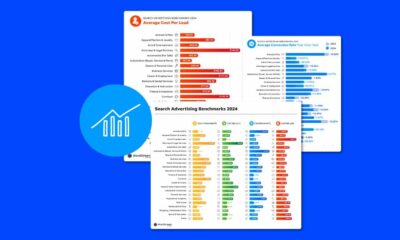AFFILIATE MARKETING
Passive Income 101: A Beginner’s Guide to Building Wealth on Autopilot

Opinions expressed by Entrepreneur contributors are their own.
In the realm of financial stability and freedom, passive income reigns supreme as a powerful tool for beginners seeking to build wealth effortlessly.
By understanding the nuances of passive income and its vast potential, budding entrepreneurs can pave their way toward financial independence. This comprehensive guide aims to decode the world of passive income and equip you with the knowledge and strategies necessary to embark on a wealth creation journey on autopilot.
Understanding passive income
Passive income refers to earnings generated with minimal effort and ongoing involvement once the initial setup is complete. It is a powerful wealth-building tool that allows individuals to earn money on autopilot, providing financial stability and freedom.
Understanding the key characteristics of passive income is crucial for aspiring entrepreneurs looking to establish sustainable income streams.
The following key attributes characterize passive income:
- Limited active participation: Passive income streams require less active involvement than traditional income forms. While some initial effort is necessary to set up the income stream, the ongoing maintenance is minimal, freeing up time for other pursuits.
- Continuous cash flow: Passive income generates regular and consistent cash flow, allowing individuals to earn money even when they are not actively working. This steady income stream helps build financial resilience and provides security.
- Scalability and leverage: Passive income has the potential for scalability, meaning that the income stream can grow over time. Moreover, it allows individuals to leverage their resources, skills or assets to multiply their earnings without significant additional effort.
Now let’s discuss the various ways that you can attain passive income.
Related: 10 Proven Passive Income Ideas for 2023
Real estate investing
Real estate investment, particularly rental properties, has long been recognized as a viable avenue for generating passive income. Understanding the benefits, risks and considerations associated with rental properties is crucial for beginners looking to embark on their real estate investment journey.
REIT investment
Invest in a real estate investment trust (REIT) traded on the stock exchange, such as VNQ for U.S. properties or VNQI for international properties.
With this approach, you can earn an average of 8% annually, with 4% coming from dividends and 4% from annual growth. These returns are comparable to those of the S&P 500.
Pros
- Worry-free investments.
- Diversification.
- No additional capital calls.
- Market downturn resilience.
- Liquidity.
- High dividends.
- Simplified taxes.
Cons
- Lower returns.
- Tax implications.
Fund or syndication investment
Invest in a fund or syndication that pools money from multiple investors to invest in one property or a portfolio of properties.
The expected annual returns can range from 8% to 25%, but a thorough evaluation of such investments is crucial.
Pros
- Higher returns.
- Trustworthy partnerships.
- Tax savings.
Cons
- The illusion of exclusivity.
- Market volatility.
- Trusting the investment.
- Managing K-1 forms.
Related: 17 Passive Income Ideas to Increase Your Cash Flow in 2023
Online investment fund
Crowdfunding platforms such as FundRise (residential) or Cadre (commercial) allow investors to own a small portion of a diversified portfolio, typically yielding 10-12% annual returns.
Pros
- Professionalism and experience.
- Transparency and reporting.
- Ease of liquidity.
Cons
- Low liquidity.
- No tax benefits.
- Medium-level returns.
Peer-to-Peer lending and crowdfunding
Peer-to-peer (P2P) lending and crowdfunding platforms have emerged as alternative passive income sources.
P2P lending involves lending money to individuals or businesses through online platforms, bypassing traditional financial institutions.
Crowdfunding platforms, on the other hand, allow individuals to invest in various projects or businesses by pooling their resources with others. These platforms provide opportunities for investors to earn returns on their investments while borrowers or project owners gain access to funding.
Pros
- Accessibility.
- Potentially high returns.
- Diversification.
- Direct connection.
- Transparency.
Cons
- Risk of default.
- Lack of regulation.
- Illiquidity.
- Platform risk.
Related: 7 Ways to Earn Passive Income From Work You Have Already Done
Affiliate marketing and niche websites
Affiliate marketing involves promoting products or services on behalf of a merchant and earning a commission for each successful referral or sale.
Niche websites, on the other hand, focus on a specific topic or target audience and provide valuable content or resources related to that niche. Affiliate marketing and niche websites can work hand in hand, offering a pathway to passive income.
Pros
- Low startup costs.
- Flexibility.
- Passive income potential.
- Scalability.
Cons
Creating and selling digital products
Creating and selling digital products has gained significant popularity in generating passive income.
Digital products include e-books, online courses, software, templates, graphic designs and music.
These products can be created once and sold repeatedly, allowing entrepreneurs to earn passive income from their expertise or creative endeavors.
Benefits
- Low production costs.
- Scalability.
- Automation.
- Global reach.
Once you begin your journey, you will undoubtedly face some challenges, and learning how to overcome them is very important. Let’s discuss this in the next section.
Overcoming challenges and pitfalls
When pursuing passive income, beginners often encounter common obstacles that can hinder their progress. Some of these challenges include:
- Lack of knowledge: Insufficient understanding of the chosen passive income stream or investment vehicle can lead to poor decision-making and suboptimal results.
- Financial constraints: Limited initial capital or resources may restrict the ability to invest in certain passive income opportunities or delay progress in wealth-building endeavors.
- Fear of failure: Fear and uncertainty can discourage beginners from taking necessary risks or exploring new ventures, limiting their potential for success.
- Time management: Balancing passive income pursuits with existing commitments or responsibilities can be a challenge, requiring effective time management and prioritization.
Related: There’s No Better Time to Start a Passive Income Business Than Now
To mitigate these risks and minimize failures in the pursuit of passive income, consider the following strategies:
- Education and research: Invest time in learning and understanding the chosen passive income streams or investment options. Stay informed about industry trends, best practices and regulatory requirements.
- Risk management: Conduct thorough due diligence and risk assessments before investing. Diversify your portfolio to spread risk and avoid overreliance on a single income stream.
- Financial planning and budgeting: Develop a comprehensive financial plan and budget to manage resources effectively and allocate funds towards passive income endeavors.
- Start small and scale: Begin with smaller investments or ventures to gain experience and confidence. As you become more comfortable and knowledgeable, gradually increase your involvement and scale your passive income activities.
- Seek professional advice: Consult with financial advisors, mentors or experts in the specific passive income field for guidance and support. Their insights can help you make informed decisions and navigate potential pitfalls.
Passive income holds immense potential for beginners seeking to build wealth on autopilot.
By understanding the various passive income streams and implementing the strategies discussed in this guide, you can take steps toward financial independence and stability.
Remember that building wealth on autopilot is a marathon, not a sprint, and every step you take brings you closer to achieving your financial goals.
SOCIAL
12 Proven Methods to Make Money Blogging in 2024

 This is a contributed article.
This is a contributed article.
The world of blogging continues to thrive in 2024, offering a compelling avenue for creative minds to share their knowledge, build an audience, and even turn their passion into profit. Whether you’re a seasoned blogger or just starting, there are numerous effective strategies to monetize your blog and achieve financial success. Here, we delve into 12 proven methods to make money blogging in 2024:
1. Embrace Niche Expertise:
Standing out in the vast blogosphere requires focus. Carving a niche allows you to cater to a specific audience with targeted content. This not only builds a loyal following but also positions you as an authority in your chosen field. Whether it’s gardening techniques, travel hacking tips, or the intricacies of cryptocurrency, delve deep into a subject you’re passionate and knowledgeable about. Targeted audiences are more receptive to monetization efforts, making them ideal for success.
2. Content is King (and Queen):
High-quality content remains the cornerstone of any successful blog. In 2024, readers crave informative, engaging, and well-written content that solves their problems, answers their questions, or entertains them. Invest time in crafting valuable blog posts, articles, or videos that resonate with your target audience.
- Focus on evergreen content: Create content that remains relevant for a long time, attracting consistent traffic and boosting your earning potential.
- Incorporate multimedia: Spice up your content with captivating images, infographics, or even videos to enhance reader engagement and improve SEO.
- Maintain consistency: Develop a regular publishing schedule to build anticipation and keep your audience coming back for more.
3. The Power of SEO:
Search Engine Optimization (SEO) ensures your blog ranks high in search engine results for relevant keywords. This increases organic traffic, the lifeblood of any monetization strategy.
- Keyword research: Use keyword research tools to identify terms your target audience searches for. Strategically incorporate these keywords into your content naturally.
- Technical SEO: Optimize your blog’s loading speed, mobile responsiveness, and overall technical aspects to improve search engine ranking.
- Backlink building: Encourage other websites to link back to your content, boosting your blog’s authority in the eyes of search engines.
4. Monetization Magic: Affiliate Marketing
Affiliate marketing allows you to earn commissions by promoting other companies’ products or services. When a reader clicks on your affiliate link and makes a purchase, you get a commission.
- Choose relevant affiliates: Promote products or services that align with your niche and resonate with your audience.
- Transparency is key: Disclose your affiliate relationships clearly to your readers and build trust.
- Integrate strategically: Don’t just bombard readers with links. Weave affiliate promotions naturally into your content, highlighting the value proposition.
5. Display Advertising: A Classic Approach
Display advertising involves placing banner ads, text ads, or other visual elements on your blog. When a reader clicks on an ad, you earn revenue.
- Choose reputable ad networks: Partner with established ad networks that offer competitive rates and relevant ads for your audience.
- Strategic ad placement: Place ads thoughtfully, avoiding an overwhelming experience for readers.
- Track your performance: Monitor ad clicks and conversions to measure the effectiveness of your ad placements and optimize for better results.
6. Offer Premium Content:
Providing exclusive, in-depth content behind a paywall can generate additional income. This could be premium blog posts, ebooks, online courses, or webinars.
- Deliver exceptional value: Ensure your premium content offers significant value that justifies the price tag.
- Multiple pricing options: Consider offering tiered subscription plans to cater to different audience needs and budgets.
- Promote effectively: Highlight the benefits of your premium content and encourage readers to subscribe.
7. Coaching and Consulting:
Leverage your expertise by offering coaching or consulting services related to your niche. Readers who find your content valuable may be interested in personalized guidance.
- Position yourself as an expert: Showcase your qualifications, experience, and client testimonials to build trust and establish your credibility.
- Offer free consultations: Provide a limited free consultation to potential clients, allowing them to experience your expertise firsthand.
- Develop clear packages: Outline different coaching or consulting packages with varying time commitments and pricing structures.
8. The Power of Community: Online Events and Webinars
Host online events or webinars related to your niche. These events offer valuable content while also providing an opportunity to promote other monetization avenues.
- Interactive and engaging: Structure your online events to be interactive with polls, Q&A sessions, or live chats. Click here to learn more about image marketing with Q&A sessions and live chats.
9. Embrace the Power of Email Marketing:
Building an email list allows you to foster stronger relationships with your audience and promote your content and offerings directly.
- Offer valuable incentives: Encourage readers to subscribe by offering exclusive content, discounts, or early access to new products.
- Segmentation is key: Segment your email list based on reader interests to send targeted campaigns that resonate more effectively.
- Regular communication: Maintain consistent communication with your subscribers through engaging newsletters or updates.
10. Sell Your Own Products:
Take your expertise to the next level by creating and selling your own products. This could be physical merchandise, digital downloads, or even printables related to your niche.
- Identify audience needs: Develop products that address the specific needs and desires of your target audience.
- High-quality offerings: Invest in creating high-quality products that offer exceptional value and user experience.
- Utilize multiple platforms: Sell your products through your blog, online marketplaces, or even social media platforms.
11. Sponsorships and Brand Collaborations:
Partner with brands or businesses relevant to your niche for sponsored content or collaborations. This can be a lucrative way to leverage your audience and generate income.
- Maintain editorial control: While working with sponsors, ensure you retain editorial control to maintain your blog’s authenticity and audience trust.
- Disclosures are essential: Clearly disclose sponsored content to readers, upholding transparency and ethical practices.
- Align with your niche: Partner with brands that complement your content and resonate with your audience.
12. Freelancing and Paid Writing Opportunities:
Your blog can serve as a springboard for freelance writing opportunities. Showcase your writing skills and expertise through your blog content, attracting potential clients.
- Target relevant publications: Identify online publications, websites, or magazines related to your niche and pitch your writing services.
- High-quality samples: Include high-quality blog posts from your site as writing samples when pitching to potential clients.
- Develop strong writing skills: Continuously hone your writing skills and stay updated on current trends in your niche to deliver exceptional work.
Conclusion:
Building a successful blog that generates income requires dedication, strategic planning, and high-quality content. In today’s digital age, there are numerous opportunities to make money online through blogging. By utilizing a combination of methods such as affiliate marketing, sponsored content, and selling digital products or services, you can leverage your blog’s potential and achieve financial success.
Remember, consistency in posting, engaging with your audience, and staying adaptable to trends are key to thriving in the ever-evolving blogosphere. Embrace new strategies, refine your approaches, and always keep your readers at the forefront of your content creation journey. With dedication and the right approach, your blog has the potential to become a valuable source of income and a platform for sharing your knowledge and passion with the world, making money online while doing what you love.
Image Credit: DepositPhotos
AFFILIATE MARKETING
This Toxic Money Habit Could Derail Your Financial Planning

Many Americans believe social media offers an inaccurate picture of wealth and success; 57% of social media users say that people post to appear more successful, and 51% of users say that social media depicts “unrealistic lifestyles,” according to a 2023 Bankrate survey.
Even so, many of them can’t help but get caught up in the cycle of comparison. Between 2022 and 2023, U.S. adults spent $71 billion on “impulse buys” they were influenced to make by social media, per Bankrate’s data — a fact that backs up an increase in “money dysmorphia.”
Related: These 5 Money Secrets Can Turn Healthy Relationships Toxic, Financial Therapist Warns
The rest of this article is locked.
Join Entrepreneur+ today for access.
AFFILIATE MARKETING
How to Get Beat Out Your Competition by Making a Lasting Impression

Opinions expressed by Entrepreneur contributors are their own.
I’m in the public relations space, and as of last count, there are more than 48,000 other PR firms in the United States. A large fraction of these compete with my agency in the five hub cities where I operate. Yet mine consistently ranks among the highest in those cities — Nashville, for example.
Is it because I know my industry better than my competitors? Because I land more placements for my clients? Because my team is more talented or my network of connections more expansive? As much as I’d like to think that I’m running with the front of the pack based solely on the quality of my services and the effectiveness of my methodologies, it’s far more likely that I earn rave reviews and generate referrals from my clients due to two words: personalized attention.
More specifically, my team and I go well above and beyond to create an exceptional customer experience at my firm because I’ve learned over the years of running my own business that it’s the client’s impression of you that matters most — that’s what informs all other aspects of customer relations, drives all other client decisions and determines if they’ll stay with you or not (even more so than short-term results).
Even in the digital age we all inhabit, with so many automated tasks and productivity tools that populate our workplaces, personalizing the professional is a surefire means to client retention and satisfaction. Here are five practices I regularly follow to make the most positive impression on my clients I possibly can.
1. Get a copy of your client’s org chart
When you understand the structure of your client’s business, you understand who does what, who reports to whom, and, in turn, you know who to go to for what. Not only is this an immense time-saver — as in not filling people’s inboxes unnecessarily with work that doesn’t pertain to them — but your clients will also appreciate that you did your homework on their staffing.
It’s so much more impressive to send a note that says, “Would your team like to see this before we send it up to Jeremy?” or “I believe Bettina has the final sign-off here” than “Are you the right person to contact about this?” And note the use of actual names here — learning the first names of everyone you’ll be working with moves you into first place faster than you’d think!
Related: 4 Ways to Make the Best First Impression With Your Customers
2. Use proper grammar and punctuation
Make sure that all your communications to your client — and, far more importantly, all the communications you prepare on their behalf — are written properly. Yes, it takes some extra work to eliminate errors. Still, it’s absolutely worth the effort when you consider how much just one typo can mar an entire project (ever seen “pubic” instead of “public”?) and how poorly faulty grammar can reflect on quality output, education level and attracting the intended audience.
Though it may be true that language standards are slipping in America, that doesn’t mean nobody’s noticing the shoddy quality of copy. Some people still notice and care. If your client is one of them, you’ll earn bonus points by knowing the difference between “compliment” and “complement” by not allowing both “San Antonio Riverwalk” and “San Antonio River Walk” in the same publication. Use your grammar checker. Always do a spell-check. Re-read everything you produce. And if you don’t have a language maven on staff to serve as your in-house proofreader, hire an affordable freelancer who can provide quick turnaround times.
3. Choose video over audio
Whenever possible, schedule video calls and videoconference meetings over phone calls and phone meetings. The day and age of in-person meetings is quickly becoming obsolete. Still, there will never be a replacement for face-to-face interaction, eye contact, observing facial expressions and showing your client with every head nod and eyebrow raise that you’re following what they’re saying and closely attending to your conversation.
During the pandemic, cultivating one-on-one relationships over Zoom and Teams became the new norm, and most people are entirely fine leaving it that way! Interacting over a screen instead of a conference table is just more convenient, time-effective and environmentally friendly. Nevertheless, we can’t afford to lose the “one-on-one interaction” part of business relationships. Remember the old Bell advertising slogan? Well, video is the modern-day equivalent of “the next best thing to being there,” so leverage your camera as often as possible to “see” your clients, not just talk to them.
4. Mark your calendar!
Notate birthdays, business anniversaries, baby due dates. Keep a record of your client’s big meetings and conference attendance. On those days, send a person-to-person text or email. And the more specific, the better, such as “Hope your coffee product presentation in Jersey went well and the traffic wasn’t too bad on the Parkway!” Or “Congrats on baby Elliot. That was my grandfather’s name, and I hope it serves your brand-new son as well as it did him.”
By incorporating the personal into the professional, which is a pillar of my own approach at my company, clients value your role more because you’ve actively endeavored to become part of their lives, not just an appendage of their business. In other words, when you add personal touches to your communications and conversations, your clients can’t help but think of you on a more human level rather than just a professional contact with whom they can easily cut ties.
Related: 6 Strategies for Making a Good First Impression During Business Meetings
5. Observe the line between personal and professional, but use both — often
On a related but separate note: As much as I’m saying to weave personal connections into your daily dealings with your clients, you never, ever want to go too far. You can use humor, but not off-color humor. You can show vulnerability, but you don’t want to appear weak or indecisive. You can ask questions and admit what you don’t know, but be strategic (not lazy) about trying to resolve issues yourself before coming to your clients with them. And be yourself, absolutely always be genuinely yourself, but don’t expose so much that you cross the line into overintimacy or inappropriate divulgence.
By speckling your client interactions with individual touches as you simultaneously maintain proper decorum, you will put a personal face on your business name. And that name will leave more of a mark on your customers precisely because of your adept balancing act between the personal and the professional.
Part of making a meaningful impression on your clients is consciously putting your best face forward every day, in every way. Don’t let them see a messy office behind you on Zoom, but let them vent about their kid’s tonsillitis for 10 minutes if needed. Don’t bad-mouth other clients or finger-point when things go wrong, but get to know them well enough that you’d love to grab a drink next time you’re in town.
Take every opportunity you can to show your clients — and then remind them often — that “business as usual” to you means being prepared (as in learning an org chart), producing quality output (that’s been proofed), scheduling face-to-face encounters, observing special occasions in their lives and sharing your authentic self, who happens to be a multifaceted, wonderful human being with flaws who’s also an utter professional and a real pro at what you do!
-

 PPC6 days ago
PPC6 days agoHow the TikTok Algorithm Works in 2024 (+9 Ways to Go Viral)
-

 SEO5 days ago
SEO5 days agoHow to Use Keywords for SEO: The Complete Beginner’s Guide
-

 MARKETING6 days ago
MARKETING6 days agoHow To Protect Your People and Brand
-

 MARKETING3 days ago
MARKETING3 days agoAdvertising on Hulu: Ad Formats, Examples & Tips
-

 MARKETING4 days ago
MARKETING4 days agoUpdates to data build service for better developer experiences
-

 MARKETING5 days ago
MARKETING5 days agoThe Ultimate Guide to Email Marketing
-

 MARKETING18 hours ago
MARKETING18 hours ago18 Events and Conferences for Black Entrepreneurs in 2024
-

 SEO7 days ago
SEO7 days agoAutomate Multi-Site Reporting With Google Sheets And GSC API













